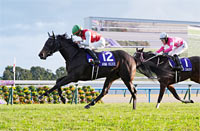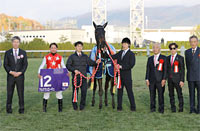Hanshin Juvenile Fillies (G1) - Data Analysis
Race to determine the “strong and beautiful” 2-year-old queen
The Hanshin Juvenile Fillies determines the best 2-year-old filly. This year, the 1,600m turf race will be held again at Hanshin Racecourse. Last year’s winner Sodashi went on to triumph in the Oka Sho (Japanese 1000 Guineas), while 3rd-placed Uberleben subsequently dominated the Yushun Himba (Japanese Oaks). In other words, runners that have chased the top places in this race often perform well in the classic races of the following spring. Let’s now look for some features shared by successful runners in this race based on results over the last 10 years.
Winners were all backed as 5th favorite or higher
Looking at performances by runners in terms of favoritism, the first thing that stands out is that the last 10 winners were all backed as 5th favorite or higher. We also find that 23 of the 30 Top 3 finishers were backed as 5th favorite or higher. If trends in recent years are anything to go by, focusing our attention on highly favored runners would seem to be the smart strategy when making our predictions. Incidentally, if we limit our analysis to the five years since 2016, we observe that runners backed as 7th favorite or lower have not finished in the Top 3. [Table 1]
[Table 1] Performance by favoritism (last 10 years)
| Favoritism |
Performance
[1st-2nd-3rd-4th or lower] |
Win ratio |
Top 2 ratio |
Top 3 ratio |
| 1st favorite |
4-1-1-4 |
40.0% |
50.0% |
60.0% |
| 2nd favorite |
1-4-0-5 |
10.0% |
50.0% |
50.0% |
| 3rd favorite |
0-1-3-6 |
0% |
10.0% |
40.0% |
| 4th favorite |
2-0-3-5 |
20.0% |
20.0% |
50.0% |
| 5th favorite |
3-0-0-7 |
30.0% |
30.0% |
30.0% |
| 6th-9th favorite |
0-2-2-36 |
0% |
5.0% |
10.0% |
| 10th favorite or lower |
0-2-1-85 |
0% |
2.3% |
3.4% |
Runners with numbers 4-12 produced many runners-up and third-place finishers
Looking at performances by runners over the last 10 years in terms of horse number, we find that the runners with numbers 1-6 have produced half of the winners. What is even more interesting is that the runners with numbers 4-12 have delivered many runners-up and third-place finishers. It may be worth considering these statistics when making our predictions. [Table 2]
[Table 2] Performance by horse number (last 10 years)
| Horse number |
Performance
[1st-2nd-3rd-4th or lower] |
Win ratio |
Top 2 ratio |
Top 3 ratio |
| 1-3 |
3-0-0-27 |
10.0% |
10.0% |
10.0% |
| 4-6 |
2-0-4-24 |
6.7% |
6.7% |
20.0% |
| 7-9 |
1-5-0-24 |
3.3% |
20.0% |
20.0% |
| 10-12 |
1-3-5-21 |
3.3% |
13.3% |
30.0% |
| 13-15 |
2-1-0-27 |
6.7% |
10.0% |
10.0% |
| 16-18 |
1-1-1-25 |
3.6% |
7.1% |
10.7% |
Runners that had previously been beaten to 4th or lower struggled
Looking at performances by runners in terms of the lowest finish since their debut race, we note that all 10 winners had never been beaten to 3rd or lower, and that the lowest finish for six of those winners was 1st, which means they entered the Hanshin Juvenile Fillies unbeaten. We also find that 27 of the 30 Top 3 finishers had never been beaten to 4th or lower. In other words, we should lower our expectations of runners that have been beaten to 4th or lower. [Table 3]
[Table 3] Performance by lowest finish since debut race (last 10 years)
| Lowest finish |
Performance
[1st-2nd-3rd-4th or lower] |
Win ratio |
Top 2 ratio |
Top 3 ratio |
| 1st |
6-4-4-27 |
14.6% |
24.4% |
34.1% |
| 2nd |
4-2-4-19 |
13.8% |
20.7% |
34.5% |
| 3rd |
0-2-1-10 |
0% |
15.4% |
23.1% |
| 4th |
0-0-0-17 |
0% |
0% |
0% |
| 5th |
0-1-0-17 |
0% |
5.6% |
5.6% |
| 6th-9th |
0-1-1-38 |
0% |
2.5% |
5.0% |
| 10th or lower |
0-0-0-20 |
0% |
0% |
0% |
Strong performances by runners that had contested a graded race following their first victory
Of the 30 Top 3 finishers over the last 10 years, 18 had contested a graded race following their first victory. Runners that had contested a graded race after their first win achieved higher success ratios than those that had contested an open-class or 1-win class after their first victory. When comparing the past track record of this year’s runners, we should therefore check races contested following a victory in a newcomer race or a maiden race. [Table 4]
[Table 4] Performance by race contested following first victory (last 10 years)
Race contested
following first victory |
Performance
[1st-2nd-3rd-4th or lower] |
Win ratio |
Top 2 ratio |
Top 3 ratio |
| Graded |
6-6-6-53 |
8.5% |
16.9% |
25.4% |
| Open class |
1-1-1-40 |
2.3% |
4.7% |
7.0% |
| 1-win class |
2-3-2-33 |
5.0% |
12.5% |
17.5% |
| First victory in previous race |
1-0-1-22 |
4.2% |
4.2% |
8.3% |
Note: Listed races are included under open-class races
Seek out the winner!
Five last winners had all triumphed in a graded race or an open-class race last time out
The last five winners had all contested a graded race or an open-class race (G3 race for four runners and open-class race for one runner) in their previous race, and had all notched the win in that race. When predicting the potential winner, we should focus on runners that have won a graded race or an open-class race in their previous race. [Table 5]
[Table 5] Winners’ previous race and finish in that race (last five years)
| Year |
Winner |
Previous race and finish |
| 2016 |
Soul Stirring |
Ivy Stakes (open-class race), 1st |
| 2017 |
Lucky Lilac |
Artemis Stakes (G3), 1st |
| 2018 |
Danon Fantasy |
KBS Kyoto Sho Fantasy Stakes (G3), 1st |
| 2019 |
Resistencia |
KBS Kyoto Sho Fantasy Stakes (G3), 1st |
| 2020 |
Sodashi |
Artemis Stakes (G3), 1st |
(Michio Kawano)
|



















